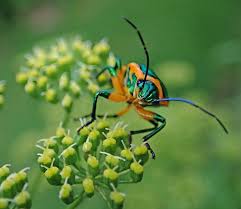Types and solutions of garden pests
Written by Joy
Sep 28 2020

Plants that are stressed by drought can bring garden pests. Frequent monitoring of crops allows you to deal with problems before pests multiply. You'd better use organic sprays sparingly as the last resort. Some plants can kill pests. Experienced organic gardening has learned valuable experience in practice, and can grow some pest-resistant plants in the garden.

1. Aphids
Aphids are very small, and insects that feed on plants will raise a variety of plants throughout the growing season.
Defensive strategy
By planting small flower plants such as mint or yarrow in the entire garden to provide food for aphids predators. You should avoid excessive fertilization, and the resulting lush and juicy bamboo shoots are aphids' magnets.
Organic control
You can squeeze the aphids with your fingers, or use a powerful water jet to wash them off the plants. You'd better use insecticidal soap spray to treat persistent infections, such as safer insecticidal soaps.
2. Carrot rust fly
Carrot rust flies are small, metallic green flies. Their larvae eat the root hairs of plants, take root and hinder plant development.
Defense strategy
Choosing crop rotation here is your best choice. You could rotate carrots and grow them in different gardens every year. It's a better choice to delay sowing until June to avoid rust flies that lay eggs in early spring and protect the seedbed with floating rows.
Organic control
Damage is usually invisible, and it is too late to know. You should be alert to stunted growth and pathological growth. You could pull and destroy infested crops and remove crop debris at the end of the season.
3. Colorado potato beetle
If you are growing potatoes, look out for the striped adults of the Colorado potato beetle on the potato leaves and stems.
Defense strategy
You can spin the potatoes slowly. You should expose and destroy the wintering adult insects. You'd better apply 4 to 6 inches of straw mulch around the plants. It's good to plant early-maturing varieties to avoid peak damage.
Organic control
You can slowly move mature potatoes and larvae and put them in soapy water. You can look for and destroy the orange eggs under the leaves.
4. Caterpillars
These gray-brown caterpillars feed on seedlings at night, cutting off the soil-level stems.
Defense strategy
You are willing to open the soil a few days before planting to expose the bugs. It is necessary to wrap the stem of each graft around 4 inches of rigid paper or press 2 inches into the soil.
Organic control
You should prepare a bran bait covered with a variety of Bacillus thuringiensis. Such as, safe garden dust and syrup, sprinkle on the bed a week before planting. You should dig next to cut seedlings to find pests.
5. Imported cabbage insects
The imported green cabbage larvae are green, one-inch-long caterpillars that eat the leaves of peacocks.
Defense Strategy
Immediately after planting, it's time to place a floating mulch-ultra-light, permeable and permeable fabric, and keep it in place until harvest.
Organic control
Destroying the cabbage insects under the leaves is the fundamental method. You should properly remove heavily infested plants and spray Bacillus thuringiensis can be used.
Latest Updated
- Benefits of Bugleweed - 7 Science-backed Health Benefits
- Bugleweed Dangers & Side Effects - Is It Poisonous?
- How to Plant Evergreen Trees - What You Should Know
- When to Plant Evergreens - Grow Guide for Evergreen Trees
- 12 Wonderful Evergreen Shrubs for Your Garden
- 12 Popular Evergreen Plants with Pictures for Beginners
- When And How To Prune A Lilac Bush Like a Pro
- How to Grow & Care for Lilac Vine (Hardenbergia Violacea)
- Japanese Lilac Tree (Syringa Reticulata) Care & Propagation Guide
- Shumard Oak Pros and Cons - What to Know
Popular Articles
- Winter maintenance of Antirrhinum Majus
- How to Grow Terminalia Mantaly Tree
- How to Grow and Care for Crossostephium Chinense
- How to grow Antirrhinum Majus in spring
- Peristeria Elata (Dove Orchid) Profile: Info & Care Guide
- Underwatered Snake Plant (Sansevieria Trifasciata) - Signs And How To Fix
- How to Care for Brazilian Jasmine Plant (Mandevilla Sanderi)
- How to Grow & Care for Graptopetalum Purple Delight in Summer
- Rosa Chinensis (China Rose): Plant Growing & Care Tips
- How to Care for Baby Sun Rose (Aptenia Cordifolia)